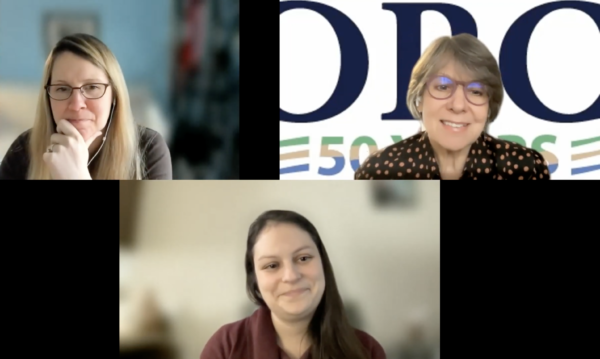Aligning Behavior for the Bay

Denice Wardrop, executive director of CRC, moderated the webinar with two expert speakers who provided new perspectives that continued January’s discussion on incorporating social science into the Bay restoration effort. Amanda Guthrie, PhD student at the Center for Coastal Resource Management (CCRM), Virginia Institute of Marine Science (VIMS); and Joanna Ogburn, Facilitator for Envision the Choptank, Principal at JBO Conservation, spoke about taking into account individual beliefs, concerns, and motivations to align social behavior, community sustainability, and the wider Bay restoration effort to achieve the best outcome for all.
Takeaways from the webinar
Amanda Guthrie (CCRM, VIMS) is looking at the intersection between ecological (e.g., dispersal among regions, water flows), and people connectivity (e.g., how people’s relationships affect their decisions) along the Chesapeake Bay shorelines. She specifically focuses on the development of living shorelines. During the webinar she talked about the values and motivations of coastal property owners and how that can affect their decision-making.
- The benefits of natural shorelines far outweigh those of non-ecologically supported structures, like riprap and bulkhead, however they are still not used as often. In many cases, people are valuing the perceived effectiveness of bulkheads over the aesthetic value of natural shorelines. Other key factors include location, property type, property value, elevation, and erosion rates.
- Community influences are also a key factor in decision-making and neighbors can be predictors of a type of modification a person has, regardless of the environmental and fiscal setting. Oftentimes, armoring is more commonly used, since it’s been around longer and people perpetuate armoring through social norms and other actions.
- Some key takeaways from the mail survey are:
- If a property is surrounded by nature and agriculture, owners are less likely to modify their shoreline property, and in this context, it’s also less likely to be riprap or bulkhead.
- People who report or erosion and reported flooding on the survey are more likely to have a living shoreline, and more likely to use the home as their primary home rather than a secondary home, such as a rental property or as a vacation home.
- It is also important to consider the researchers and people working in this space and how their motivations, values, and interests align with and potentially impact aspects of a project.
Joanna Ogburn (JBO Conservation) is a consultant that focuses on bringing people together to solve shared conservation challenges. She works on building, facilitating, and advising multi-stakeholder collaborations and serves as the coordinator and facilitator for Envision the Choptank, a collaborative partnership that works with conservation organizations, government agencies and local citizens to find solutions that support healthy and productive oyster reefs, and restore fishable, swimmable waters in the Choptank River watershed.
- The partnership is modeled on the Collective Impact Framework, which aims to move from fragmented action to collective action in order to make a deep and durable impact. The framework has five core conditions, common agenda, shared measurement systems, mutually reinforcing activities, continuous communication, and backbone support.
- There is never a framework that is going to fit all the needs of a group or community so it is important to know who you working with and the realities and context in which you’re working; listen to those you are working to engage and understand their needs, interests, and concerns; and be adaptive to what is working and what is not and try new or different approaches.
- An in-depth stakeholder engagement process was conducted early in the partnership, which involved interviewing 64 practitioners across a variety of fields, to understand the challenges in improving and maintaining the health of the Choptank River watershed and to identify some potential solutions to overcome those challenges. This information and feedback was used to develop the common agenda for the Choptank River watershed, which included a series of goals, objectives and strategies.
- Two common principles that are consistent across all audiences are the need to fill in gaps in capacity and provide boots on the ground, and to listen, learn, and adapt from those you’re trying to engage, especially people who have worked in these areas previously.
- A current program is working with agricultural landowners to implement three types of best management practices that research has shown to be some of the most effective at improving water quality. The program foundation is based on the feedback from the stakeholder engagement process and involves an advisory group from the agricultural community, flexible and tailored incentive programs, and a full-time dedicated landowner assistance coordinator.
Resources for further action
- Conservation social science: Understanding and integrating human dimensions to improve conservation, Bennett et al. 2017
- The application of reflexivity for conservation science, Beck et al. 2021
